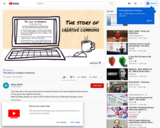
This video tells a story about why and how Creative Commons (CC) was founded; and why and how CC has grown into a global movement.
- Subject:
- Education
- Material Type:
- Diagram/Illustration
- Author:
- Wahyu Setioko
- Date Added:
- 11/28/2020

This video tells a story about why and how Creative Commons (CC) was founded; and why and how CC has grown into a global movement.
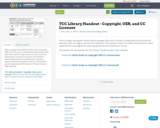
This is a 3-page "quick guide" handout about copyright, OER, and CC licenses, including what they look like and what they mean for usage in and out of the classroom. This handout is meant for students and would be a useful supplement for any assignments requiring openly licensed multimedia or sources. This handout also accompanies the TCC Library's "Student Guide to OER" LibGuide.

This module was created in response to an observed need by BranchED and the module authors for efforts to increase the recognition, adaptation, and use of open educational resources (OER) among pre- and in-service teachers and the faculty who work in educator preparation programs. The module's purpose is to position teacher educators, teacher candidates and in-service teachers as empowered content creators. By explicitly teaching educators about content that has been licensed for re-use and informing them about their range of options for making their own works available to others, they will gain agency and can make inclusive and equity-minded decisions about curriculum content. The module provides instructional materials, resources, and activities about copyright, fair use, public domain, OER, and visual literacy to provide users with a framework for selecting, modifying, and developing curriculum materials.

This module provides faculty in higher education with an introduction to the use and creation of Open Educational Resources. It is intended for faculty who are new to the principles of Open Education. Several of the examples in this module relate to higher education in Canada, but you are encouraged to adapt the resources you suit your context.It can be used as part of a course on open education and would benefit from an expanded discussion of Open Pedagogy, an additional module on Open Access, and a module on Developing Open Policies for higher education institutions.

This lesson introduces you to the basics of U.S. copyright protection. Copyright is a form of legal protection that allows authors and other creators to control their original, creative work.By the end, you will be able to distinguish between what qualifies for copyright protection and what does not, as well as define basic copyright terms such as public domain and derivative.The content in this lesson is organized using the 6 Ws, outlined below:Why does copyright protection exist?Whose work is protected by copyright?What can copyright holders do with their copyrights?Which works can be protected by copyright?When is a work protected by copyright?Where are copyrighted works protected?

It has never been easier to publish online or consume digital content. This comes with many advantages and can make teaching and learning so much more targeted and impactful. Living in a digital world also brings up many questions — one issue that is very important to understand is copyright.
Whether you’re an educator, student, or blogger, copyright is a topic that is often overlooked as it can be confusing or just not considered important.
Unfortunately, there are also a lot of myths about copyright circulating amongst the education community. Maybe you’ve heard that you can use any images or texts you find online if you’re using them for education? Or perhaps you’ve heard that you can use any songs in your videos as long as you use less than 30 seconds? Yep, both not true.
Copyright is important for all teachers, students, and bloggers to know about. And it doesn’t have to be as complicated as you think. We’re here to break down the basics of copyright and other related topics like fair use, public domain, and Creative Commons.

Learn about OER and Creative Commons Licenses and how to find, create and share OER with proper attribution.
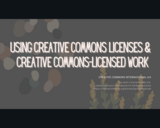
A look at how Creative Commons are applied to allow for remix, adaptation, and derivatives, and how to stay between the lines with each type of permission or restriction.

This infographic covers the basics for using and reusing Creative Commons licensed works. An accessible infographic transcript is available at this url: https://docs.google.com/document/d/19t5E49ynzEAu4tMnYKCz9yeqkr-Jr6Vbu7iPT23V1HE/edit?usp=sharing
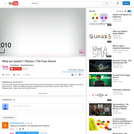
Find out what quarks are, how they were discovered and why they are very important in relation to protons and neutrons. There are different types of quarks which you'll learn about in this GCSE / K12 "Radioactivity" video from the Virtual School.

Learn about copyright law with this overview resource.Created by Jes Graham for the second assignment of the Creative Commons Course.

Learn about Creative Commons with this overview resource.Created by Jes Graham for the first assignment of the Creative Commons Course.
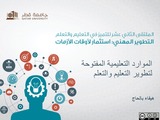
مع تطور التكنولوجيا و الويب، أصبح من السهل لاي متصفح إيجاد المعلومات و المراجع و أصبح البعض يستعملها دون الاهتمام بالملكية الفكرية و دون التأكد من صحة و نجاعة هذه المعلومات. من أجل حماية الكاتب واتاحة فرص أكبر للمستعمل والتشجيع على اصدار محتوى تعليمي ذي جودة، انتشرت حركة الموارد التعليمية المفتوحة في العالم.
- فماهي هذه الموارد؟ وماهي تراخيص الملكية الفكرية التي تحكم استخدامها؟
- كيف يمكن للأستاذ ان يجدها بسهولة على الوب؟
- كيف تساعده على الابتكار في ظل منهج التعليم المتمركز حول المتعلم؟
كل هذه الأسئلة يطرحها هذا العرض الذي قدم في الملتقى الثاني عشر للتميز لمركز التميز في التعليم و التعلم بجامعة قطر.